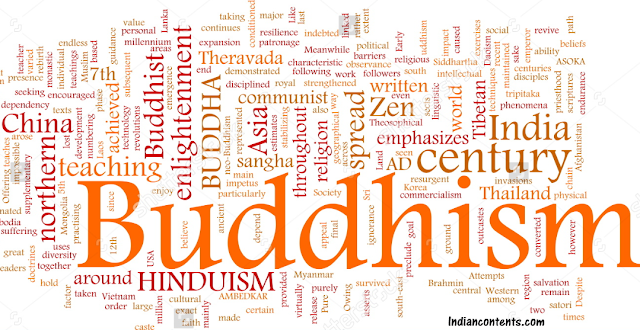"Be kind to all creatures, that is the true Religion"
-Buddha
What is Buddhism?
Buddhism is a way of
finding peace within oneself. It is
a religion that helps us to find the happiness and contentment we seek.
Buddhists develop inner peace, kindness and wisdom through their daily
practice; and then share their experience with others bringing real benefit to
this world. They try not to harm others and to live peacefully and gently,
working towards the ultimate goal of pure and lasting happiness for all living
beings.
Origin of buddhism
History says that
Buddhism originated from the teachings
of Siddhartha Gautama(Buddha Shakyamuni) who is typically referred to as
the Buddha (literally the "Awakened"
or "Enlightened One").He was born in the 5th century B.C. in the
Indian state of Kapilavastu, now
part of Nepal. This makes it one of the oldest religions practiced today. Buddhism
is an important religion in most of the countries of Asia. The religion evolved
as it spread from the northeastern region of the Indian subcontinent through
Central, East, and South East Asia.
Rather than the
founder of a new religion, Siddhartha Gautama was the founder and leader of a
sect of wanderer ascetics (Sramanas),
which is one of many sects that existed at that time all over India. This sect
came to be known as Sangha to distinguish it from other
similar communities.
History
The founder of
Buddhism in this world is Buddha Shakyamuni.
He was born as a royal prince in 624 BC in a place called Lumbini, which was originally in northern India but is now part of
Nepal. ‘Shakya’ is the name of the
royal family into which he was born, and ‘Muni’
means ‘Able One’. His parents gave
him the name Siddhartha and there were many wonderful predictions about his
future. According to legend, at his birth a soothsayer predicted that he might
become a renouncer (withdrawing from the temporal life). To prevent this, his
father provided him with many luxuries and pleasures.
When he was young, he
once went on a series of four chariot
rides where he first saw the more severe forms of human suffering: old age,
illness, and death (a corpse), as
well as an ascetic renouncer. The contrast between his life and this human
suffering made him realize that all the pleasures on earth where in fact
transitory, and could only mask human suffering. Leaving his wife and new son
(Rahula) he took on several teachers and tried severe renunciation in the
forest until the point of near-starvation. Finally, realizing that this too was
only adding more suffering, he ate food and sat down beneath a Peepal tree to
meditate. By morning (or some say six months later) he had attained Enlightenment (Nirvana), which provided
both the true answers to the causes of suffering and permanent release from it.
And that tree is the (Peepal) Bodhi tree
in Bodh Gaya, in Bihar state of India
Buddha found patronage in the ruler emperor Bimbisara of Magadha.
Emperor Bimbisara accepted Buddhism as his personal faith and granted
permission to develop Buddhism in Magadha.
At Sarnath a place near
Sacred Hindu city of Varanasi, Buddha
started Wheel of Dharma by
delivering his first sermon to a group of five companions with whom he had
previously sought enlightenment. Together with the Buddha they formed the first
monastic community of ordained Buddhist monks or nuns. These teachings which
include the Sutra of the Four Noble Truths and other discourses, are the
principal source of the Hinayana
(Lesser Vehicle) of Buddhism. Later, Buddha taught the second and third Wheels
of Dharma, which include the Perfection of Wisdom Sutras and the Sutra
Discriminating the Intention respectively. These teachings are the source of
the Mahayana (Great Vehicle) of
Buddhism. In the Hinayana teachings
Buddha explains how to attain liberation from suffering for oneself alone, and
in the Mahayana teachings he
explains how to attain full enlightenment, or Buddhahood, for the sake of others.
By the time of his death, the Buddha's followers are established
as communities of monks in northern India. Wandering through villages and towns
with their begging bowls, eager to describe the path to the truth, they are
familiar figures.
The advance of the Buddhists beyond the others is largely due to
the enthusiastic support of a king of the 3rd century BC Asoka, who rules over
much of the Indian subcontinent. His inscriptions, carved on pillars and rocks
throughout his realm, bear witness both to the spread of Buddhism and to his
own freehearted support of the Buddha's principles.
During Asoka's reign, and with his encouragement, Buddhism spreads
to south India and into Sri Lanka. The latter has remained to this day a
stronghold of the earliest form of Buddhism, known as Theravada.











0 Comments